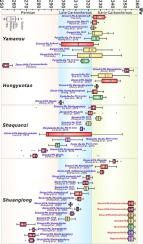Zircon and garnet U-Pb dating reveals the mineralization history of volcanic-related skarn iron deposits
IF 2.7
3区 地球科学
Q2 GEOSCIENCES, MULTIDISCIPLINARY
引用次数: 0
Abstract
The genesis of skarn garnet in volcanic-related skarn iron deposits is controversial because of the absent or ambiguous spatiotemporally related intrusions. In this study, we present combined LA-ICP-MS garnet U-Pb and SHRIMP zircon U-Pb ages to determine the spatiotemporal relationship between skarn garnet and a potentially related intrusion or causative volcanic rock. Three types of garnet (Grt1, Grt2, and Grt3) are identified in the Yamansu deposit, and Grt1 yields a lower intercept age of 326 ± 9 Ma (n = 32, MSWD = 0.3). SHRIMP zircon U-Pb dating of the associated volcanic rock yields a weighted mean age of 327 ± 3 Ma (n = 10, MSWD = 1.4), suggesting an isochronous relationship between the volcanic rock and Grt1. Grt2 and Grt3 yield lower intercept ages of 316 ± 6 Ma (n = 22, MSWD = 1.4) and 315 ± 6 Ma (n = 35, MSWD = 1.5), respectively. However, the zircon U-Pb weighted mean age of 252 ± 4 Ma (n = 5, MSWD = 0.8) obtained from the associated intrusion is obviously younger than the skarn age and the previously reported ore-forming age, implying no temporal relationship between mineralization and the intrusion. More significantly, precise 206Pb/238U weighted mean ages of 325 ± 9 Ma (n = 15, MSWD = 0.3), 316 ± 8 Ma (n = 11, MSWD = 0.4), and 319 ± 7 Ma (n = 12, MSWD = 0.5) were obtained from Grt1, Grt2, and Grt3, respectively, and we find that andradite-rich garnet with high U and ΣREE concentrations has the potential to yield the more precise U-Pb ages. The combined garnet and zircon U-Pb ages reveal that the hydrothermal skarn and mineralization in volcanic-related skarn iron deposits are related to volcanic activity rather than intrusions. Multiple episodes of volcanic-related hydrothermal activity may have caused multiple phases of skarn formation and mineralization in volcanic-related skarn iron deposits.

锆石和石榴石 U-Pb 定年揭示了与火山有关的矽卡岩铁矿床的成矿史
与火山有关的矽卡岩铁矿床中的矽卡岩石榴石的成因存在争议,因为不存在或模糊不清的时空相关侵入体。在这项研究中,我们结合LA-ICP-MS石榴石U-Pb年龄和SHRIMP锆石U-Pb年龄,确定了矽卡岩石榴石与可能相关的侵入体或成因火山岩之间的时空关系。在 Yamansu 矿床中发现了三种类型的石榴石(Grt1、Grt2 和 Grt3),Grt1 得到的较低截距年龄为 326 ± 9 Ma(n = 32,MSWD = 0.3)。对相关火山岩进行 SHRIMP 锆石 U-Pb 测定,得出的加权平均年龄为 327 ± 3 Ma(n = 10,MSWD = 1.4),表明火山岩与 Grt1 之间存在等时关系。Grt2和Grt3的截距年龄较低,分别为316 ± 6 Ma(n = 22,MSWD = 1.4)和315 ± 6 Ma(n = 35,MSWD = 1.5)。然而,从相关侵入体中获得的锆石 U-Pb 加权平均年龄为 252 ± 4 Ma(n = 5,MSWD = 0.8),明显比矽卡岩年龄和之前报告的成矿年龄年轻,这意味着成矿与侵入体之间没有时间关系。更重要的是,从Grt1、Grt2和Grt3获得的精确206Pb/238U加权平均年龄分别为325 ± 9 Ma(n = 15,MSWD = 0.3)、316 ± 8 Ma(n = 11,MSWD = 0.4)和319 ± 7 Ma(n = 12,MSWD = 0.5)。综合石榴石和锆石的 U-Pb 年龄显示,与火山有关的矽卡岩铁矿床中的热液矽卡岩和矿化与火山活动有关,而不是与侵入活动有关。与火山有关的多期热液活动可能导致了与火山有关的矽卡岩铁矿床中多个阶段的矽卡岩形成和矿化。
本文章由计算机程序翻译,如有差异,请以英文原文为准。
求助全文
约1分钟内获得全文
求助全文
来源期刊

Journal of Asian Earth Sciences
地学-地球科学综合
CiteScore
5.90
自引率
10.00%
发文量
324
审稿时长
71 days
期刊介绍:
Journal of Asian Earth Sciences has an open access mirror journal Journal of Asian Earth Sciences: X, sharing the same aims and scope, editorial team, submission system and rigorous peer review.
The Journal of Asian Earth Sciences is an international interdisciplinary journal devoted to all aspects of research related to the solid Earth Sciences of Asia. The Journal publishes high quality, peer-reviewed scientific papers on the regional geology, tectonics, geochemistry and geophysics of Asia. It will be devoted primarily to research papers but short communications relating to new developments of broad interest, reviews and book reviews will also be included. Papers must have international appeal and should present work of more than local significance.
The scope includes deep processes of the Asian continent and its adjacent oceans; seismology and earthquakes; orogeny, magmatism, metamorphism and volcanism; growth, deformation and destruction of the Asian crust; crust-mantle interaction; evolution of life (early life, biostratigraphy, biogeography and mass-extinction); fluids, fluxes and reservoirs of mineral and energy resources; surface processes (weathering, erosion, transport and deposition of sediments) and resulting geomorphology; and the response of the Earth to global climate change as viewed within the Asian continent and surrounding oceans.
 求助内容:
求助内容: 应助结果提醒方式:
应助结果提醒方式:


